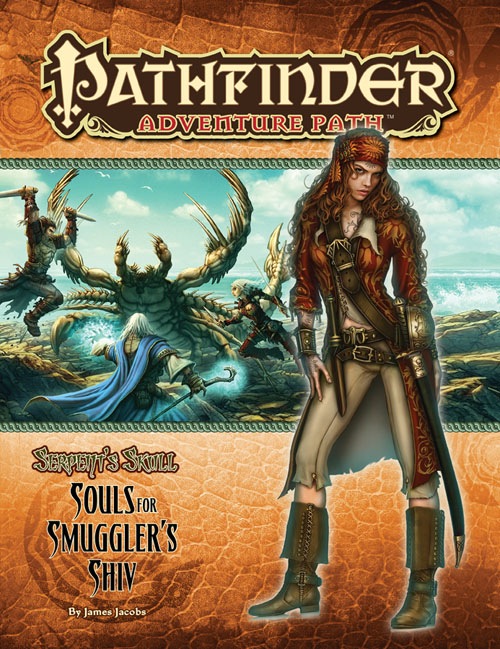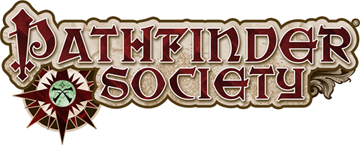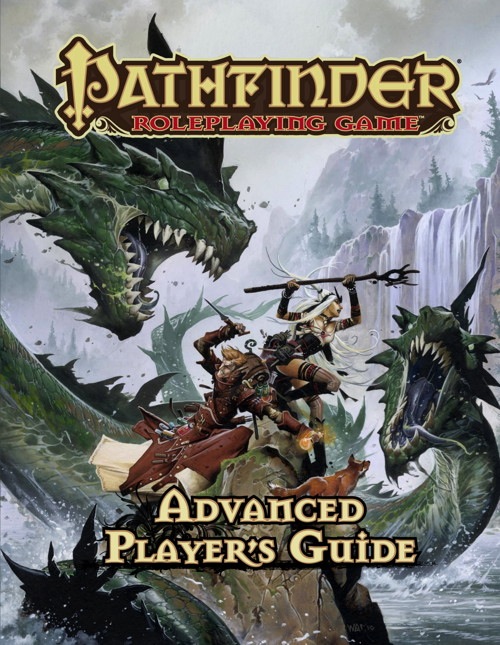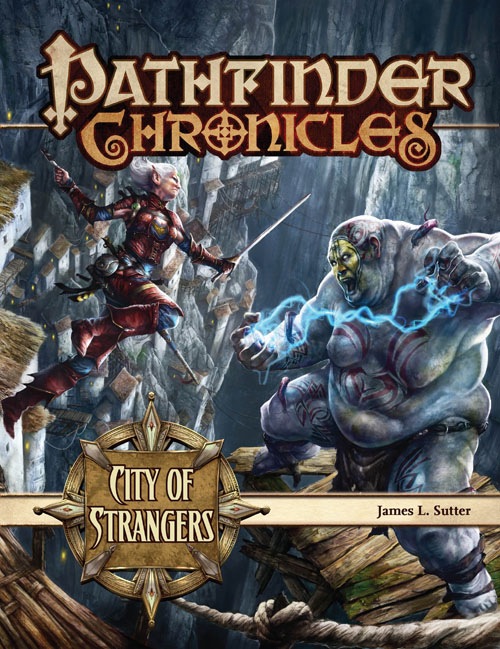 PaizoCon 2012 was this weekend in Redmond, Washington. PaizoCon is sponsored by Paizo of course and an event packed with Pathfinder fans. While I did not attend the event, thanks to social media I was able to keep up with the announcements that occurred at The PaizoCon Banquet that happened on Saturday night. The Banquet is where upcoming products are shown and secrets revealed.
PaizoCon 2012 was this weekend in Redmond, Washington. PaizoCon is sponsored by Paizo of course and an event packed with Pathfinder fans. While I did not attend the event, thanks to social media I was able to keep up with the announcements that occurred at The PaizoCon Banquet that happened on Saturday night. The Banquet is where upcoming products are shown and secrets revealed.
Using what I have picked up via various social media locations including Twitter, Facebook and Paizo‘s own blog The Iron Tavern will take a look at some of the product announcements and comment on them. (I will provide a short summary of the announcement and then follow it with a comments section).
Ultimate Equipment Guide
The Ultimate Equipment Guide release is coming up quickly. The book will include all core source material and more. There will be pictures of each piece of equipment referenced in the core book and includes a section on mundane equipment. This book will use a new way to present the material and wondrous items will be presented by slot for those times your character is looking to fill a particular slot.
Comments
I am looking forward to this release. I like equipment and I am one of the types that even enjoys mundane equipment. I am likely looking forward to that chapter more than anything else! Having the equipment consolidated into one book will be quite handy and I see this as being an excellent resource for Pathfinder games (and possibly borrowing equipment for other games).
I certainly understand organizing wondrous items by slot, though it does lend to the feeling of the book being a shopping catalog for players. It will be interesting to see if it turns players into “shoppers” more so than they are now or not. Regardless, there has to be some organization system and I suppose by slot works as well as another despite the possible implication.
NPC Codex
This sourcebook was announced for November of this year and weighs in at 320 pages. It will contain one page per NPC and a statblock for every class in the core book. The builds in this book will alternate between typical builds and more atypical builds using even and odd levels as the differential.
Comments
I am in the middle of the road on this one. I will likely have a better idea of where I fall on this one after it is released. While there is certainly a need for NPCs and such, I feel like I have a good number to work now from various sources.
There is certainly something to be said in having them all in one place though. Also knowing that you can find a certain class at a certain level when picking up the book will also be a pro. At this point I am thinking this will be a good PDF resource for me, not sure I would go in for the physical product.
Ultimate Campaign
This book will be coming in the Spring of 2013 and cover what happens between adventures. Things such as improving skills, running guilds, building keeps, managing businesses and more will be included. Rules for waging war and building kingdoms will also be included as well as information for random background generation.
Comments
This book looks promising to me. There has long been an interest in some of the items that happen between adventures. Building ones estate, wealth, and such has been an area where GMs have frequently cobbled together rules for their campaigns. It will be interesting to see what the folks at Paizo come out with for this. This book could be a very valuable resource to cover all of those things between adventures we have typically run off the cuff or turned to previous edition rulebooks for.
Player Companion Line
The next volume will cover Varisia and feature a visual redesign. The idea is that these books are read in brief, five minute increments and are being designed to reflect that. Roads with distances will be added to the Varisia maps with this release.
The line is moving to a monthly release cycle and a rules index will be put in place to help make finding information easier.
Comments
I do not purchase as lot of the Player Companion Line presently. I pick one up here or there, sometimes based on reviews or if one covers a topic I have a particular interest in at the moment.
It will be interesting to see how the redesign affects my purchasing habits. Roads on maps sounds intriguing. More traits and crunch is a downside for me as I tend to feel overwhelmed by the amount of crunch via traits, feats, and archetypes as the Pathfinder line grows. I love the fluff, the crunch not so much. I am sure others enjoy the flow of mechanics with these releases, so I suspect this will prove a good move for Paizo despite my preferences.
Adventure Paths
Shattered Star is the next Adventure Path coming around the corner. This one sounds a little more like a traditional dungeon crawl. Expect gray maidens, giants, drow, a demi-lich and more from this one. Also players will be able to play as member of a Pathfinder faction.
Reign of Winter will be the next AP and brings Baba Yaga to Golarion. They announced some of the titles of each installment:
- Snows of Summer
- The Shackled Hut
- Maiden Mother Crone
- Rasputin Must Die
- Revenge of the Witch Queen
Comments
Shattered Star will likely see my return to an Adventure Path subscriber. While I have enjoyed Paizo’s playing around the edges with the past few APs, I am looking forward to a return to a more traditional series.
Reign of Winter also sounds interesting as well. I like the area this is likely to take place in after my reading of Winter Witch and some of the scenarios from the Pathfinder Society Play.
Looks like a promising time ahead for the Adventure Path series from where I sit.
Paizo GameSpace
This is Paizo’s entry into the virtual tabletop space. Expected this summer this is a virtual tabletop that runs in a browser, no plug-ins required. It will be cross-platform as well. The VTT will not implement the Pathfinder rules system, but does include an initiative tracker and dice roller.
In efforts to minimize GM prep-work high resolution maps and tokens will be provided for adventure paths to get people up and running quickly with less prep. It will support zooming on the map and token movement. They were doing demos of this at the banquet.
The VTT will be free to use for people though it sounds like there will be pay for options for additions. The details to this are still being worked out at the moment. The primary motivation for this VTT is to provide a place for the community to play.
Comments
This strikes me as one of the big two announcements that came from PaizoCon. Gamers all around know Wizards has been working on getting a VTT out the door and to the public since 4e was announced. There have been some setbacks for them along the way and it seems that Paizo is possibly trying to fill this gap.
I think they are approaching this the right way for the moment. They have said that software is an evolving thing, so the plan is to release it early and possibly update as time goes on. The focus being to get something out there on the market and fix issues post release. By keeping the rules out of it that simplifies the project a fair amount.
The part of this announcement I am not a huge fan of is that I would like to have seen them support one of the existing free VTTs already out there. Either something like MapTool, the upcoming Tabletop Forge or even the other newcomer, Roll20.net. These tools have a lot of the heavy lifting already complete or near complete and could readily take campaign files provided by Paizo.
I suspect Paizo is choosing to release their own simply for the control factor, i.e. they do not want to see what they base their releases on fold leaving them without a VTT. The other possibility is if they do manage to work the purchase of assets into their VTT for enhancements they stand more to gain by controlling the VTT as a whole.
I am interested to see how this one shapes up. VTTs are an excellent way to facilitate more people gaming.
Pathfinder Adventure Card Game
This was the other big announcement from the banquet in my eyes – a deck building card game from Paizo. This game is to be released at GenCon 2013 and the first set will have 400 cards. From what I have read so far it is a cooperative game and plays in about an hour.
Comments
I have mixed feelings about this. While I have no idea of the inner workings at Paizo it seems Paizo is trying to do a lot of things in a rather short time frame. We have the support of an MMO, card games, minis, VTT, and increasing the release cycle for some of their subscriptions. I just hope they don’t lose focus on producing high quality supplements and APs as we move forward.
There are some smart people that have been around this business for a long time though. I am sure they have looked at the market, the risks and what it can do for their business before these projects were given the go ahead.
With that said, I am not really in the market for a deck building game and will likely pass on this offering when it is released next year. Perhaps my initial thoughts about this game will change as the year passes.
Overall it looks like a very exciting PaizoCon Banquet this year! Lots of new things coming from Paizo as they continue to keep everyone in the RPG industry on their toes!
 My local group recently finished up Council of Thieves. I did not run the campaign, the other GM in my group has been running it. This past week we started in on Serpent’s Skull. That sounds typical of a lot of Pathfinder groups I am sure. Finish one Adventure Path and then move to the next. The difference in this case is that our GM let us bring our characters from Council of Thieves to the Serpent’s Skull campaign. 10th level characters tackling a 1st level adventure.
My local group recently finished up Council of Thieves. I did not run the campaign, the other GM in my group has been running it. This past week we started in on Serpent’s Skull. That sounds typical of a lot of Pathfinder groups I am sure. Finish one Adventure Path and then move to the next. The difference in this case is that our GM let us bring our characters from Council of Thieves to the Serpent’s Skull campaign. 10th level characters tackling a 1st level adventure.



















